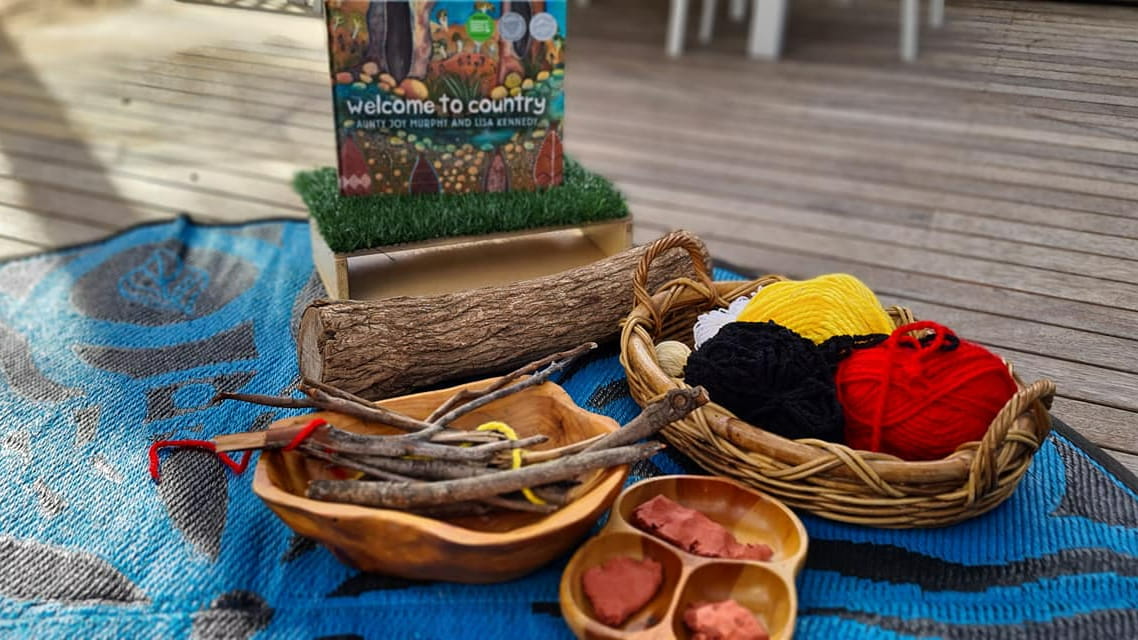By Dr Mia Christensen, Education Manager, Innovation and Partnerships.
What is NAIDOC week?
Each year in July, NAIDOC Week is recognised across Australia to celebrate the history, culture, and achievements of Aboriginal and Torres Strait Islander peoples. While we embed Aboriginal and Torres Strait Island perspectives, knowledges, and pedagogies within our daily practice across the year, NAIDOC week provides a specific theme for the month of July.
The 2022 theme – Get Up! Stand up! Show Up! recognises the history of getting up, standing up, and showing up. From the Frontier Wars to Aboriginal and Torres Strait Islander communities and supporters fighting for change today, there is a history of courage and determination not to lose momentum for change.
For Aboriginal and Torres Strait Islander people Country is more than a place; it is inherent to their identity, and it sustains every aspect of life – spiritually, physically, emotionally, socially, and culturally. Aboriginal and Torres Strait Islander histories, languages, and cultures are integral to Australia’s national identity.
How we acknowledge it
At G8 Education, it is key for us as teachers and educators to weave Aboriginal and Torres Strait Island stories into our daily practice, to be mindful of the third cultural space that recognises that Aboriginal and Torres Strait Islander communities have distinct and deep cultural and world views – views that differ from those found in most Western education and care systems. To do this, as part of our daily curriculum we need to talk with young children about Aboriginal and Torres Strait Islander peoples’ relationship with the lands and territories now known as Australia and recognise First Nations peoples as the first explorers, first navigators, first engineers, first farmers, first botanists, first scientists, first diplomats, first astronomers and first artists.
Embedding practices will look different in each of our centres. Here are some things you may see:
- Coming together at the beginning of the day to speak an Acknowledgment to the Traditional Owners or Custodians of the lands on which the centre is located.
- Using a yarning circle arrangement as a way for children to share their thinking and stories with each other.
- A written acknowledgment in the reception area, along with the display of an Aboriginal Flag and a Torres Strait Islander flag.
- Discussion and display of the Aboriginal and Torres Strait Islander Language Map.
- Contemporary, traditional, urban and regional representations of Aboriginal and Torres Strait Islander peoples and cultures across all areas of the room through the inclusion of books, puzzles, music, imagery, textiles, and dolls.
- Drawing from Aboriginal pedagogies (ways of teaching) to engage children in learning experiences such as using natural materials, making land links with local environments, and using symbols and images to represent concepts and tell stories.
- Engagement with Aboriginal and/or Torres Strait Islander people which is reciprocal and benefits both parties. Engagement may include input into the curriculum, learning experiences, guidance on cultural integrity or ongoing connections with community groups.

At our Kingsgrove World of Learning centre, the younger children explored the meaning behind the colours on the Aboriginal flag through yarning circle discussions and painting natural materials. The educators also initiated an ongoing ‘meeting place’ for children where they meet each morning to participate in an Acknowledgement of Country, greet one another, and share stories.
Resources and further reading
Websites
- National NAIDOC Secretariat: 2022 NAIDOC Week theme announced: Get Up! Stand up! Show Up!
- Little Yarns for Little People: https://www.abc.net.au/kidslisten/ideas/earlylearning/little-yarns/11225658?fbclid=IwAR3arhjCONK52_EGItT4biLUAJFx4zTZ4O8CxiU6TsjlFhdvc-wJKp49cwg
- Reconciliation Australia: Share our pride: http://shareourpride.reconciliation.org.au/
- Map of Aboriginal and Torres Strait Islander Australia: Map of Indigenous Australia | AIATSIS
Readings
- Connor, J. (n.d.). Dreaming Stories: A springboard for learning. ED497531.pdf
- Miller, M. (2018). Embedding Aboriginal and Torres Strait Islander perspectives. Pedagogy+: The Art of Teaching, April/May (3), 50-51. https://eprints.qut.edu.au/119430/
- Miller, M. (2016). Reconciliation in early childhood settings: A whole-team approach. Every Child, 22(4), 4-5. https://eprints.qut.edu.au/103008/
- Miller, M. (2012). Breaking down the barriers. Bedrock. https://issuu.com/ieunswact/docs/bedrock
Other groups
- The Koori Curriculum (facilitated by Jessica Staines, a Wiradjuri woman and early childhood teacher)
- Connecting2Culture (facilitated by Jackie Bennett, a Kamilaroi, Bigambul woman with many years’ experience supporting educational contexts)
